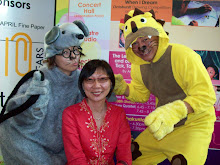The new LAS Council and the Programmes and Social Committee 2011/2012 organised the New Year Bash 2012 today to celebrate the dawn of the new year!
Many librarians attended the "New Year Bash" following the advised dress code "Anything that says Happy New Year", so it looked very much like a rehearsal for a CNY (Chinese New Year) gathering!
With a low price of $10, a super special rate just for LAS members, all of us enjoyed a feast that we would not forget with the delicious food and fruits prepared by the Halal Kitchen of Rendezvous Hotel.
Besides the new year festivities that accompany the ushering in of 2012, LAS members who attended this event also witnessed something special, i.e., the LAS awards to fellow librarians in recognition of their commitment to and passion for the profession.
And here is the list:
1. Lifetime Contribution Award – Mr Chan Thye Seng
2. Professional Service Award – Ms Ngian Lek Choh (National Library Board)
3. Outstanding Newcomer Award – Mr Aaron Tay Chee Hsien (NUS Libraries)
4. Library School Scholarship - Mr Cheng Eng Aun (NUS Libraries)
5. Special Librarian Passion Award – Ms Charlotte Gill (Li Ka Shing Library)
I took the opportunity to congratulate them on their dedication to the profession and cheered them on with fellow LAS members!
Programme:
Date: Sat 7 Jan 2012
Venue: Rendezvous Hotel, Level 2, Straits Ballroom
Time: 9.30am-1.00pm
- 09.30 am Registration
- 10.00 am Opening and the LAS Awards
- 11.00 pm Brunch/Networking/New Year Activities
- 12.45 pm End of programme
What left an impression in my mind is Mr Aaron Tay's humorous speech which he delivered after receiving the "Outstanding Newcomer Award".
The "serious-looking" award winner said he gets frustrated quite easily and when that happens, he likes to read the article "An open letter to new librarians" by Roy Tennant " http://blog.libraryjournal.com/tennantdigitallibraries/2011/02/18/an-open-letter-to-new-librarians/
"Deeply committed and visionary people will also tend to be frustrated and impatient. But I’m here to tell you that with dedication and patience you will not only survive, but thrive. Our profession is counting on you to do so. Only the best and the brightest are frustrated. Everyone else is bored, or unengaged, or biding their time for retirement. You are the ones we simply cannot do without."
Hence, remember that the best and most committed librarians get frustrated ... if you're frustrated, you are a good librarian. If you're not frustrated, then you're bored, unengaged or near retirement.
After hearing that and noting it down, my friend Yvonne Yin related it to me and said, "He quoted Roy Tennant, the name you mentioned to me as a must read author for librarians some time back. Looks like Aaron thought the same!" I was surprised that Yvonne remembered what I had said long ago. It was something like a refreshment to my memory.
We were pleased that Aaron, the award winner, was of "like mind" with us! Hence, we got hold of him after the lunch and had a photo taken together. I also invited Gene Tan, the LAS president, who won our hearts with his opening speech this morning to join us to mark the day!
From left to right: Ms Yvonne Yin, Mr Aaron Tay (Winner of Outstanding Newcomer Award), Dexterine Ho and Mr Gene Tan
I was also joyfully surprised to be selected as one of the three "Best new year dress" winners -- the other two were Ms Foo Yan Chuin and Mr Cheng Eng Aun. We were given book vouchers from Kinokuniya Singapore and I think that is the best gift for librarians!
A big "thank you" to Ms Susan Song (See photo below) who selected me for the award and the event organiser: LAS Council the Programmes and Social Committee 2011/2012!
When we were about to leave the ballroom reception area, both Yvonne and I were excited to see Datin Patricia Lim and Ms Ngian Lek Choh on their way out, and we jumped at the chance of having our photos taken with them! That made our day really "great" as we highly value their contributions to the world of librarianship in Singapore! We are so pleased to had the honour of taking a photo with them and capturing the moment and keeping it for life!
From left to right: Ms Yvonne Yin Yee Ying, Dexterine Ho Soo Miang, Ms Ngian Lek Choh and Datin Patricia Lim Pui Huen.
Notes:
*Ms Yvonne Yin Yee Ying: Assistant Manager, Cataloguing, at National Institute of Education
*Mr Aaron Tay Chee Hsien: Senior Librarian at National University of Singapore Libraries
*Mr Gene Tan: Director, National Library. Office and Programme Director of Singapore Memory Project
*Ms Ngian Lek Choh:
Deputy Chief Executive of NLB and Director of National Library
*Datin Patricia Lim Pui Huen: Founding Librarian of the Institute of Southeast Asian Studies, now an independent scholar, writing on local history.
*Ms Dexterine Ho Soo Miang, LAS WSQ Level 2 course Trainer and Assessor; Lecturer and course planner, INNO HANDS-ON. Ex-Librarian: NIE, NTU and Temasek Poly Library; Ex-Lecturer & Adjunct Lecturer: Temasek and Nanyany Poly, NIE.
Notes:
* Professional Development Scheme (PDS) Points
* Eligible for PDS Points: This activity attracts 46 points under the Industry Knowledge Development (ID) category." Participate in library related talks, forums, discussion sessions and business meetings (e.g. AGM, Council & Committee meetings) organized by LAS or other libraries (provided they are open to LAS members or other librarians) "
Edited and revised on 24 Jan 2012 with advice from Ms Yvonne Yin and photos from LAS facebook album!
Dexterine Ho Soo Miang
(Revised on 12 May 2017)










